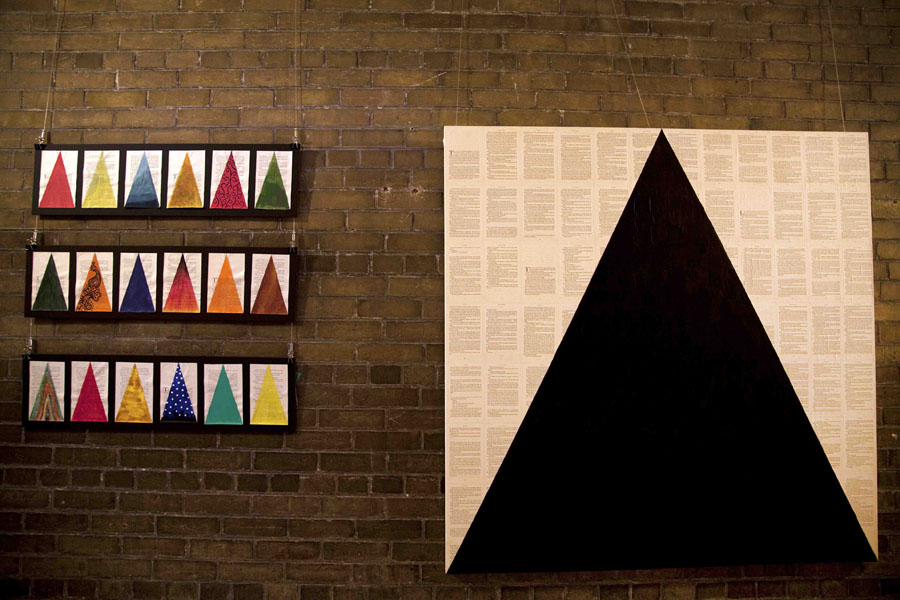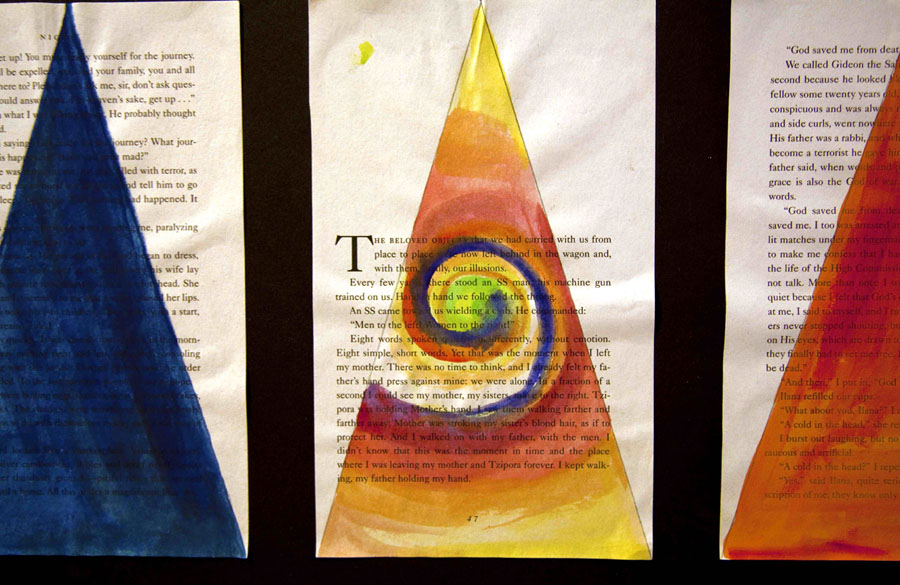|
Unit 5: Art and Remembrance
Chapter 1: Creating a Holocaust Exhibit
 |
Educator Tools
Published in English in 1960, Night is Elie Wiesel’s personal account of the Nazi death camps, and is one of the most significant testimonies of the Holocaust experience. The artwork in the exhibit “After Night” was created by members of the Teaching to Learn Project. It was composed of thirty teachers and adolescents who brought multiple perspectives and horizons of experience to bear on their artistic interpretations, as they grappled with the difficult themes and unspeakable horrors documented in Wiesel’s Night. Did you know about this?TrianglesNazis demarcated “undesirables” with badges made of triangles. Inverted triangles were an analogy for road hazard signs. Triangles of different colours were used to represent the different groups deemed as threats to the Nazi regime: red triangles designated political prisoners, especially communists; pink: sexual offenders and homosexual men; green: criminals; black: “asocials” and Roma (Gypsies); yellow triangles forming a Star of David, or two yellow triangles, combined, were used to mark Jews. In the 1970s, gay rights advocates reclaimed the pink triangle as a form of protest and a symbol of pride. In the spirit of this activist reclamation, the artists painted triangles in colors chosen to represent diversity, solidarity, and individuality. This process included designing, cutting and painting on pages from Night. Colors for the large canvases were chosen and painted collectively. These paintings responded through color and symbol to themes in the Holocaust memoir by Elie Wiesel. Each painting contained nearly the entire text—96 of 113 pages— of Night. Their artistic interpretations of Night took place over the span of a year, and culminated in an art exhibit. These people explored how Night could be a platform for literary and historical inquiry as well as a catalyst for social change. Wiesel (2005) himself noted that the purpose of Holocaust education is not to passively encounter the messages of survivors but rather to encourage readers themselves to become the messengers; or to paraphrase Paul Celan (2001), to act as “witnesses for the witnesses.” This exhibition was a collective response to Wiesel’s testimony of his experiences in the Auschwitz and Buchenwald camps from 1944 until his liberation in 1945 at the age of 16. One of the young artists shared her insights into the process and the symbolic and representational power of color in the After Night exhibit: “After reading Night and completing the project, the colours used to paint the triangles are not just colours any more. The triangle that we painted blue was very interesting for me. It showed different levels in intensity in the colour (streaks) that could represent many things. It could mean the good and evil during the Holocaust. I saw it as [symbolizing] many different sides to the Holocaust. The different blotches of colour represent the different people involved, and how each person has their own story, whether they are a victim or an abuser. Choosing the colours was more something I felt than thought of; I think for people viewing the exhibit it is the same. As there is no description of why we chose that colour or what we think it represents, it is really up to the viewers to determine what the colours mean and one way to do that would be to just feel.” As Robert Fulford said, “Trust the art, not the artist.” Like the artists themselves, middle school students who viewed After Night at the exhibit expressed a range of responses to the artwork, from the emotional and personal, to the aesthetic and historical. Comments from Middle school observers:
ACTION 1ThinkA. What is the role of art after the Holocaust? Are films more or less effective than visual art? B. How does this form of interpreting history affect viewers? Artists? Students? C. Do these types of artwork memorialize or trivialize the pain and suffering of the Holocaust? ACTION 2DoDesigning a Two-Dimensional Memorial
ACTION 3DoDesigning a Three-Dimensional Model of a Memorial by Drawing, Painting or Creating a ModelThree options: A. Create a modeled (shaded) drawing:
B. Design a three-dimensional structure painted with a single colour to emphasize the forms:
C. May be completed as an architectural rendering or as a model. Every effort has been made to gain permission from copyright holders to reproduce borrowed material. The publishers apologize for any errors and will be pleased to rectify them in subsequent reprints and website programming. Educator ToolsOther chapters on Art and Remembrance: |


